Significantly improving mechanical, thermal and dielectric properties of cyanate ester resin through building a new crosslinked network with unique polysiloxane@polyimide core–shell microsphere†
Abstract
High-performance thermosetting resin (HPTR) has been a key fundamental material in many cutting-edge industrial fields. However, it is still a challenge to develop an HPTR that simultaneously possesses higher heat resistance, toughness and rigidity. Herein, a new soft-core hard-shell microsphere (PSi@PI) with active groups, composed of polysiloxane (PSi) as core and polyimide (PI) as shell, was designed and synthesized. It has excellent thermal stability, the initial decomposition temperature (Tdi) being as high as 447 °C. PSi@PI microspheres were embodied into cyanate ester (CE) resin to prepare a series of PSi@PI/CE resins using a melt-blending technique. The mechanical, thermal and dielectric properties of PSi@PI/CE resins were systematically studied. The results show that PSi@PI/CE resins have much better mechanical, thermal and dielectric properties than CE resin. Typically, the impact strength of 2PSi@PI/CE (with 2 wt% PSi@PI) is 28 kJ m−2, about 1.8 times of that of CE resin; moreover, 2PSi@PI/CE has an even higher storage modulus than CE resin. Note that the Tdi and glass transition temperature of 2PSi@PI/CE are 450 °C and 300 °C, respectively, about 4–14 °C higher than that of CE resin. Moreover, compared to CE resin, PSi@PI/CE has lower dielectric constant and loss. These attractive comprehensive properties of PSi@PI/CE demonstrate that PSi@PI is a high-efficiency multi-functional filler, which has great potential in the preparation of HPTRs, especially those for fields with demanding requirements in terms of outstanding integrated performances, including heat resistance, toughness, rigidity, and dielectric properties.


 Please wait while we load your content...
Please wait while we load your content...